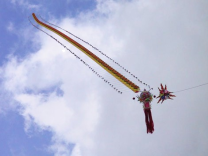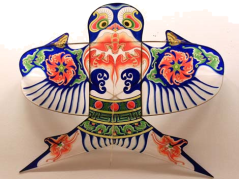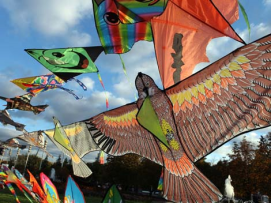
China is universally acknowledged as the birthplace of kites. Kites originated in the Spring and Autumn Period over 2,000 years ago. Legend has it that the wooden bird made by the ancient philosopher Mozi was the earliest kite. Later, his disciple Lu Ban made some improvement on the wooden kite by using bamboo as the material. The creation gradually evolved into current multi-line kites.

Folklorists hold that ancient people invented kites to be in memory of dead family members and friends. That’s why they would fly kites on the Qingming Festival, a day ancient people believed the gate of hell would throw open, to send their greetings to their loved ones who passed away via the kite. In the Tang and Song Dynasties, due to the booming of paper making industry, people began to make kites with paper. In the late Tang Dynasty, some people added musical strings to kites. When the wind blew, the kites gave out sounds like the guzheng (an ancient Chinese music instrument), hence the name of “Feng Zheng” (literally meaning “Zheng in the wind”). In the Song Dynasty, flying kites became a popular outdoor activity, with lots of poems and paintings portraying kite-flying scenes.

In ancient times, apart from being an entertainment article, a kite could also be used for military purposes, such as distance measuring, information transmitting and dangerous spot crossing etc. In 190 BC, when the war between Chu and Han was underway, the Han general Han Xin used a kite to measure the length of the tunnel under the Weiyang Palace when he launched an attack against the palace. And during the Battle of Gaixia, when Xiang Yu’s troops were surrounded by Liu Bang’s troops, Han Xin ordered the making of a cowhide kite, with a bamboo flute attached to it. When the kite was flown in the wind, the Han army sang some Chu songs with the flute, breaking up the Chu army’s morale. The Han army won the battle in the end. This was the origin of the Chinese idiom “Simian Chuge” (literally meaning “Chu songs all around”, it’s a phrase that means “under attack from all directions”).
Today, Weifang City of Shandong Province is widely regarded as “the world’s capital of kites”. The most famous kites of Weifang are Longting (Dragon Pavilion) and Julong (Giant Dragon) kites. In Kaifeng, there’s an age-old custom still popular today. On the Qingming Festival, people fly kites as high and far as possible and cut the line on purpose, allowing the kites to drift in the sky with the wind. This is a symbol of letting go the unhappiness and sadness accumulated in the previous year, which is believed to keep illnesses at bay during the whole year. In addition, a kite is a carrier of hope. If a fish is drawn on a swallow-shaped kite, it has a hidden meaning of “the wish of surplus every year”, because the word “fish” has the same pronunciation as that of “surplus” in Chinese. If bats, peaches, pine trees and cranes are painted on a kite, it means fortune, wealth and longevity.
【小题1】According to the text who invented the first kite?【小题2】What was the kite used for in ancient times?
【小题3】Why would the ancient people fly kites on the Qingming Festival?
【小题4】Explain the Chinese idiom “Simian Chuge” in English.
【小题5】Why do people fly kites as high and far as possible and cut the line deliberately?


